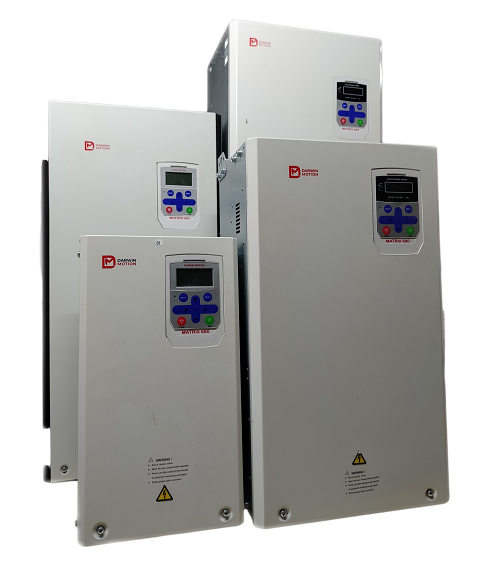Posted on 17th Mar 2025

An AC Drive, also known as a VFD (Variable Frequency Drive), is a system used to control the speed and torque of an alternating current (AC) motor by varying the frequency and voltage supplied to the motor. AC drives are commonly used in industrial applications such as conveyors, pumps, HVAC systems, and fans to optimize energy usage, improve process control, and reduce wear on machinery. An AC drive typically consists of several key components that work together to achieve motor control.
The rectifier is the first component in an AC drive system. Its role is to convert the incoming AC power into DC (Direct Current). This is achieved using a set of diodes or thyristors that rectify the AC voltage. The rectifier usually consists of a three-phase bridge rectifier in industrial applications. The DC voltage generated is used to power the rest of the drive system.
Diode Rectifiers: Simple, reliable, and cost-effective but have limited control.
Thyristor Rectifiers: Provide better control over the power conversion process, allowing for more flexibility.
The DC link, often referred to as the DC bus, is the section of the AC drive where the DC voltage is stored after being converted by the rectifier. This is typically achieved through the use of capacitors. The purpose of the DC link is to smooth out any fluctuations or ripples in the DC voltage to ensure a steady flow of power to the inverter.
Capacitors: These are used to stabilize the DC voltage and reduce ripples, ensuring smooth power delivery to the inverter.
Inductors: In some systems, inductors are also used to further filter the DC signal.
The inverter is one of the most important components of an AC drive. Its function is to convert the DC voltage from the DC link back into an AC signal, but at a variable frequency and voltage to control the motor's speed. This conversion is achieved using power transistors like IGBTs (Insulated Gate Bipolar Transistors) or MOSFETs (Metal-Oxide-Semiconductor Field-Effect Transistors), which are able to switch at high speeds to produce a controlled AC output.
Pulse Width Modulation (PWM): This is the technique used by the inverter to produce a sine wave output by switching the transistors on and off at high frequencies.
The control circuit is responsible for monitoring and adjusting the operation of the drive. It processes input signals from the user, such as desired speed or torque, and adjusts the output to the motor accordingly. The control circuit uses a variety of sensors and algorithms to maintain the desired performance.
Microcontroller / Digital Signal Processor (DSP): Modern AC drives often use microcontrollers or DSPs to manage the speed control, protection, and diagnostics of the system.
PID Controllers: The control system uses feedback loops, often in the form of PID (Proportional, Integral, Derivative) control, to fine-tune motor speed, torque, and acceleration.
The HMI allows operators to interact with the AC drive system. It typically consists of a display screen, buttons, or touchpad that provides the user with access to control settings, fault diagnostics, and real-time performance data. The HMI is essential for tuning the drive, setting parameters, and troubleshooting.
Feedback systems, such as encoders and tachometers, provide real-time data on the motor's performance. These sensors help the AC drive system adjust the output based on the motor's actual performance compared to the desired settings. For example, encoders measure the rotational speed and position of the motor shaft, allowing the drive to maintain precise speed control.
Encoders: Provide position and speed feedback to ensure accurate motor control.
Current and Voltage Sensors: Monitor the motor's electrical parameters to protect against overloads or faults.
AC drives are equipped with various protection features to ensure safe operation and to prevent damage to the motor and drive components. Some of the common protection features include:
Overcurrent Protection: Prevents the drive from supplying excessive current to the motor.
Overvoltage and Undervoltage Protection: Ensures that voltage levels are within the safe operating range.
Overtemperature Protection: Protects the system from overheating by monitoring temperature levels within the drive.
Short Circuit Protection: Detects and protects against electrical short circuits.
Due to the high power processing involved, AC drives generate heat. To maintain performance and prevent overheating, many drives have an integrated cooling system. This can include fans, heat sinks, or liquid cooling systems depending on the size and application of the AC drive.
An AC drive is a sophisticated device that integrates various components to efficiently control the speed and torque of an AC motor. From the rectifier that converts AC to DC, to the inverter that outputs variable-frequency AC, and the control circuit that processes user inputs and feedback, each part of the AC drive plays a crucial role in ensuring optimal motor control. By offering precise control over motor performance, AC drives improve energy efficiency, reduce mechanical wear, and enhance the overall performance of machinery in industrial applications.